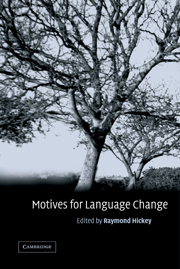Book contents
- Frontmatter
- Contents
- Notes on the contributors
- Acknowledgements
- Introduction
- Part I The phenomenon of language change
- Part II Linguistic models and language change
- Part III Grammaticalisation
- Part IV The social context for language change
- Part V Contact-based explanations
- 10 The quest for the most ‘parsimonious’ explanations: endogeny vs. contact revisited
- 11 Diagnosing prehistoric language contact
- 12 The ingenerate motivation of sound change
- 13 How do dialects get the features they have? On the process of new dialect formation
- Part VI The typological perspective
- Index
- References
11 - Diagnosing prehistoric language contact
Published online by Cambridge University Press: 22 September 2009
- Frontmatter
- Contents
- Notes on the contributors
- Acknowledgements
- Introduction
- Part I The phenomenon of language change
- Part II Linguistic models and language change
- Part III Grammaticalisation
- Part IV The social context for language change
- Part V Contact-based explanations
- 10 The quest for the most ‘parsimonious’ explanations: endogeny vs. contact revisited
- 11 Diagnosing prehistoric language contact
- 12 The ingenerate motivation of sound change
- 13 How do dialects get the features they have? On the process of new dialect formation
- Part VI The typological perspective
- Index
- References
Summary
Introduction
The goal of this chapter is to look at the possibility of using various patterns in comparative data to reconstruct different kinds of language contact. I ask the reader to forgive a somewhat autobiographical introduction, but this is the most direct way I know of explaining why this goal is worthy of pursuit.
I spent much of the 1980s on an analysis of genetic relationships among the two hundred or so Oceanic Austronesian languages of northwest Melanesia (Papua New Guinea and the western Solomon Islands), using the classical comparative method of historical linguistics (Ross 1988). One of the things I noticed again and again was the quantity of data which was left unaccounted for. In the case of lexical items this was either because there was nothing in other languages to compare them with (that is, there were no cognate forms) or because they did not show regular sound correspondences with apparent cognates in other languages. More significantly, there were other patterns in the data which I could not account for because the comparative method does not have much to say about them. They consisted, for example, of:
an apparent sudden increase in phonological and morphological complexity in a single language compared with its neighbours;
radical differences in syntax between languages which seemed otherwise quite closely related;
similarities in semantic organisation, sometimes accompanied by syntactic similarity, which were expressed by quite different forms in the relevant languages.
- Type
- Chapter
- Information
- Motives for Language Change , pp. 174 - 198Publisher: Cambridge University PressPrint publication year: 2003
References
- 14
- Cited by



